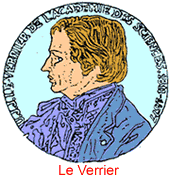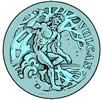
Dimdima
Online Children's Magazine from India

Dimdima
Online Children's Magazine from India

In 1859 a French doctor and amateur astronomer named Lescarbault observed what he thought was a planet moving between Mercury and the sun. Many other astronomers reported seeing a small black disc moving against the backdrop of the brilliant sun. Their observations were seconded by the great French astronomer Urbain Le Verrier.
In 1846 Le Verrier had studied the motion of the planet Uranus and come to the conclusion that another planet beyond it was influencing its movements. His calculations led to the discovery of the planet which many people wanted to name after him but was eventually named Neptune.
Le Verrier supported the theory of a planet between Mercury and the sun because, like Uranus, Mercury does not move in the orbit one would expect it to follow on the basis of Newton's laws of gravitation. Le Verrier felt it was being pulled by an unknown planet. He named this planet Vulcan. 
He calculated that Vulcan would have a diameter of 1000 miles and would be about 19 million miles away from the sun.
A planet so close to the sun would naturally be hard to see because of the solar glare. Astronomers tried to observe it during solar eclipses, but without success. Le Verrier predicted that the best view of the planet would be possible on 22nd March 1877.
But the day came and went without anyone catching sight of the mysterious planet, much to the embarrassment of Le Verrier who was lampooned in the French press. A year later two Americans, Watson and Swift, reported seeing the planet, but their observations were not confirmed by others.
Interest in the planet began to wane. Textbook publishers who had included Vulcan in the list of planets, in their books, quietly deleted the name and Mercury regained its position as the innermost planet of the solar system.
EXPLORE MORE...
Get Help or Give Help.
- Do you have a Science Question?
- Post it here and get the answer.
- Some questions posted by others are not yet answered.
- View those questions and answer them.
Dimdima is the Sanskrit word for ‘drumbeat’. In olden days, victory in battle was heralded by the beat of drums or any important news to be conveyed to the people used to be accompanied with drumbeats.
Bharatiya Vidya Bhavan
K. M Munshi Marg,
Chowpatty, Mumbai - 400 007
email : editor@dimdima.com
Bharatiya Vidya Bhavan
505, Sane Guruji Marg,
Tardeo, Mumbai - 400 034
email : promo@dimdima.com
Dimdima.com, the Children's Website of Bharatiya Vidya Bhavan launched in 2000 and came out with a Printed version of Dimdima Magazine in 2004. At present the Printed Version have more than 35,000 subscribers from India and Abroad.